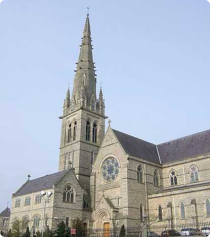
Summary: St Eunan (or Adomnan), born in Donegal around 624 and died in 704. He became a monk in Iona and was chosen as abbot there in 679. In addition to overseeing the Columban monasteries, he left important writings, one of which is the Life of Colum Cille. He was known as a good and wise man, remarkably learned in Sacred Scripture.
Patrick Duffy tells his story.
 The Uí Chonaill Family
The Uí Chonaill Family
Born in Donegal into the Uí Chonaill family, Adomnán, or Eunan, as he is more commonly known today may have spent some time at the Columban monastery in Durrow before joining the Iona community where he was chosen as its ninth abbot in 679.
The image(left) is of a window of St Patrick
at the cathedral in Letterkenny.
Eunan intervened to liberate war captives and to claim safety during war for women, children and clerics. His open-mindedness also led to the ending of the conflict between the Roman and Celtic Churches.
His Life of Columba
He wrote a Life of Columba, to whom he was related. Although its purpose is not strict history, but to highlight the saint’s virtues, and is modelled on the Lives of the Desert Fathers especially Antony and Evagrius, it is full of memorable descriptions. It stresses Columba’s relationship with God and his fight against exploitation, carelessness, falsehood, and murder. Adomnan upholds Columba as an Irish saint whose faith transcends petty divisions.
De Locis Sanctis
Adomnán also wrote a book on the “holy places” – Jerusalem, Damascus, Constantinople and Alexandria – called De Locis Sanctis. It is based on descriptions given him by word of mouth by a French bishop Arculfus, who had been shipwrecked in western Britain and took refuge in Iona.

St Eunan
Conflict between Celtic and Roman usage in the Irish Church
As the ultimate superior of the Ionan monastery of Lindisfarne, Adomnán made a number of visits to Northumbria. The first was in 686. While he was there, he became aware of the unresolved conflict and tensions in the years after the Synod of Whitby (664) between Celtic observances and the Roman observances. Celtic monasteries had a different method for calculating the date of Easter, a different tonsure, and the abbot held administrative superiority to a bishop.
Reconciliation
In visiting the monasteries of Wearmouth and Jarrow, Adomnán held long discussions with the Abbot Ceolfrith of Wearmouth. Eventually he became convinced that, whatever about the equally sacred origins of the differing customs – the Celtic way was based on St John and had long been the custom in the Eastern Church – it was better for the universality of the Church for the Celts to adopt the Roman usage. Over the next eighteen years he tirelessly worked to convince Iona and other Celtic monasteries to do so.
Setting Captives free
Another reason for Adomnán’s visit to Northumbria in 686 was to persuade King Aldfrith to release sixty Irish prisoners and in this he was successful. When later he attended the Synod of Birr in 697, he convinced the participants that women, children and clerics should be exempt from war and not be taken prisoners or slaughtered. This came to be known as The Law of the Innocents or Adamnan’s law (Cain Adomhnáin) – and is a kind of preview of the present-day Geneva Convention.
<<St. Eunan’s Cathedral, Letterkenny,
Co. Donegal.
St Eunan, Patron
of Raphoe Diocese
Adaomnán or Eunan, as he is now more commonly called in Ireland, is the principal patron of the diocese and the cathedral in Letterkenny is called after him.
___________________
******************************
Memorable Vision for Today
Unity doesn”t happen magically ,
It’s often takes work, is messy,
can be very uncomfortable,
and happens gradually.
~ Sharon Eubank ~
******************************